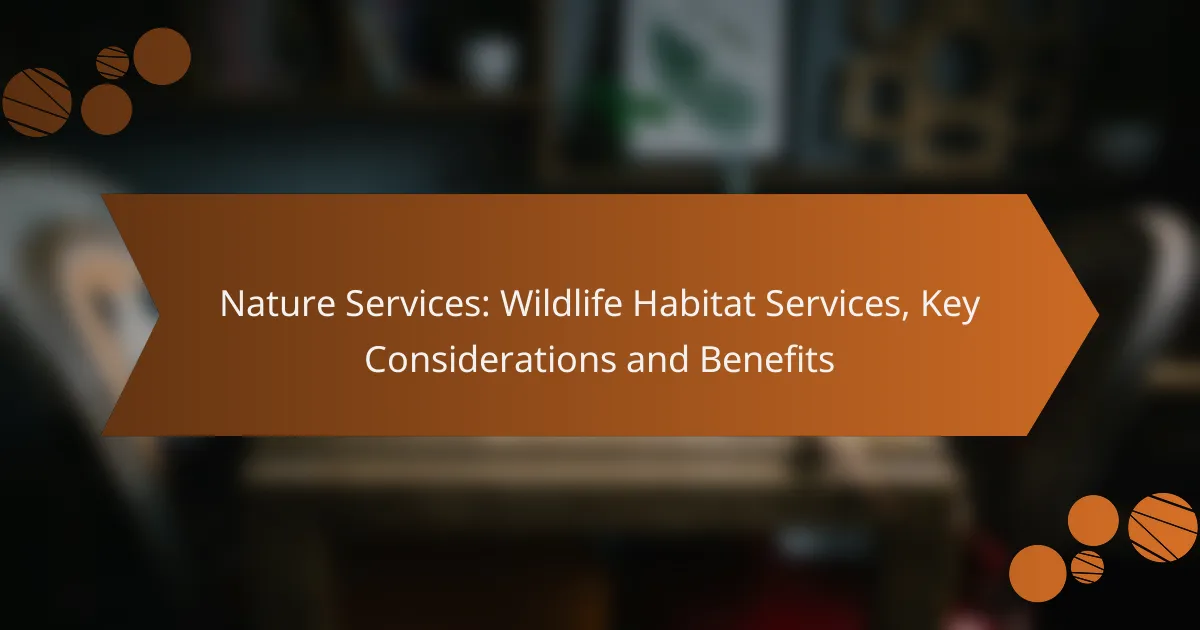Wildlife habitat services are essential for promoting biodiversity and ecological health in urban areas. By focusing on habitat restoration, wildlife monitoring, and community education, these services not only support various species but also enhance the overall resilience of local ecosystems. Careful consideration of site-specific needs and community involvement is vital to ensure the effectiveness and sustainability of these initiatives.

What wildlife habitat services are available in urban areas?
Urban areas offer various wildlife habitat services designed to support biodiversity and enhance ecological health. These services include habitat restoration, wildlife monitoring, invasive species management, and community education initiatives, all aimed at fostering a sustainable environment for both wildlife and residents.
Habitat restoration services
Habitat restoration services focus on rehabilitating degraded ecosystems within urban settings. This can involve replanting native vegetation, removing barriers to wildlife movement, and restoring natural water flows. Effective restoration often requires collaboration with local governments and community organizations to ensure the use of appropriate native species and techniques.
For instance, transforming vacant lots into green spaces can provide essential habitats for birds and pollinators. Engaging local volunteers in planting and maintenance can also foster community involvement and awareness of local wildlife needs.
Wildlife monitoring programs
Wildlife monitoring programs are essential for tracking the health and diversity of urban wildlife populations. These programs often utilize citizen science, where community members help collect data on species sightings and behaviors. This information can inform conservation strategies and help identify areas needing protection or enhancement.
Examples include bird counts during migration seasons or tracking the presence of specific species in local parks. Regular monitoring can also help assess the effectiveness of habitat restoration efforts and guide future initiatives.
Invasive species management
Invasive species management is critical in urban areas, where non-native plants and animals can disrupt local ecosystems. Effective management strategies include identifying invasive species, educating the public on their impacts, and implementing removal or control measures. This often involves partnerships with local environmental groups and government agencies.
For example, removing invasive plants like Japanese knotweed can help restore native plant communities, which in turn supports local wildlife. Regular community workshops can empower residents to recognize and report invasive species in their neighborhoods.
Community education initiatives
Community education initiatives aim to raise awareness about the importance of wildlife habitats and the services they provide. These programs can include workshops, school programs, and informational campaigns that highlight local wildlife and conservation efforts. Engaging the community fosters a sense of stewardship and encourages participation in habitat protection.
For instance, organizing nature walks or habitat restoration days can educate residents about local ecosystems while promoting hands-on involvement. Providing resources such as brochures or online guides can further enhance understanding and appreciation of urban wildlife habitats.
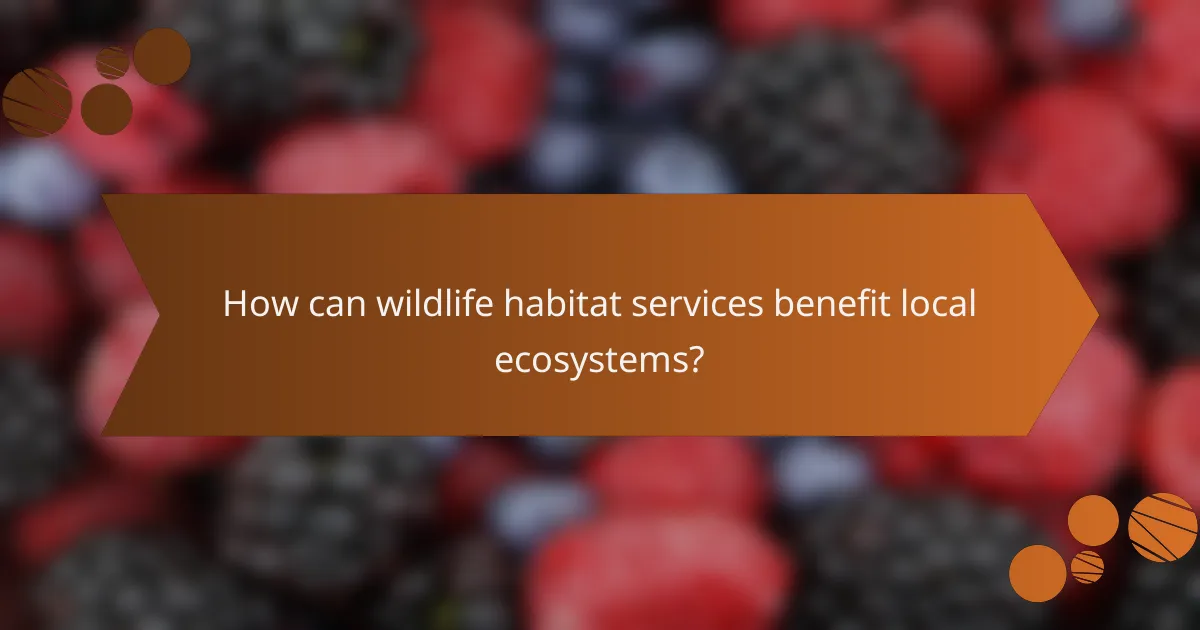
How can wildlife habitat services benefit local ecosystems?
Wildlife habitat services play a crucial role in enhancing local ecosystems by providing essential support for various species and promoting ecological balance. These services contribute to biodiversity, strengthen ecosystem resilience, and aid in the protection of endangered species, ultimately fostering healthier environments.
Enhancement of biodiversity
Wildlife habitat services significantly enhance biodiversity by creating and maintaining environments where diverse species can thrive. This includes preserving natural habitats such as forests, wetlands, and grasslands, which serve as homes for numerous plants and animals.
By fostering a variety of species, these services help maintain ecological balance, as different organisms contribute to processes like pollination, seed dispersal, and nutrient cycling. For example, a diverse plant community can support a wider range of pollinators, which in turn boosts food production for both wildlife and humans.
Improved ecosystem resilience
Improved ecosystem resilience is another key benefit of wildlife habitat services. Resilient ecosystems can better withstand environmental changes, such as climate fluctuations, disease outbreaks, and invasive species. By maintaining healthy habitats, these services help ecosystems recover more quickly from disturbances.
For instance, wetlands act as natural buffers against flooding and drought, absorbing excess water during heavy rains and releasing it during dry spells. This ability to adapt to changing conditions is vital for sustaining both wildlife populations and human communities.
Support for endangered species
Wildlife habitat services provide essential support for endangered species by protecting their natural habitats and ensuring they have access to necessary resources. This includes creating conservation areas and implementing management practices that minimize human impact on vulnerable populations.
For example, establishing protected areas can help safeguard critical breeding grounds for endangered birds or marine life, allowing these species to recover and thrive. Additionally, habitat restoration projects can rehabilitate degraded areas, making them suitable for reintroducing endangered species back into their natural environments.
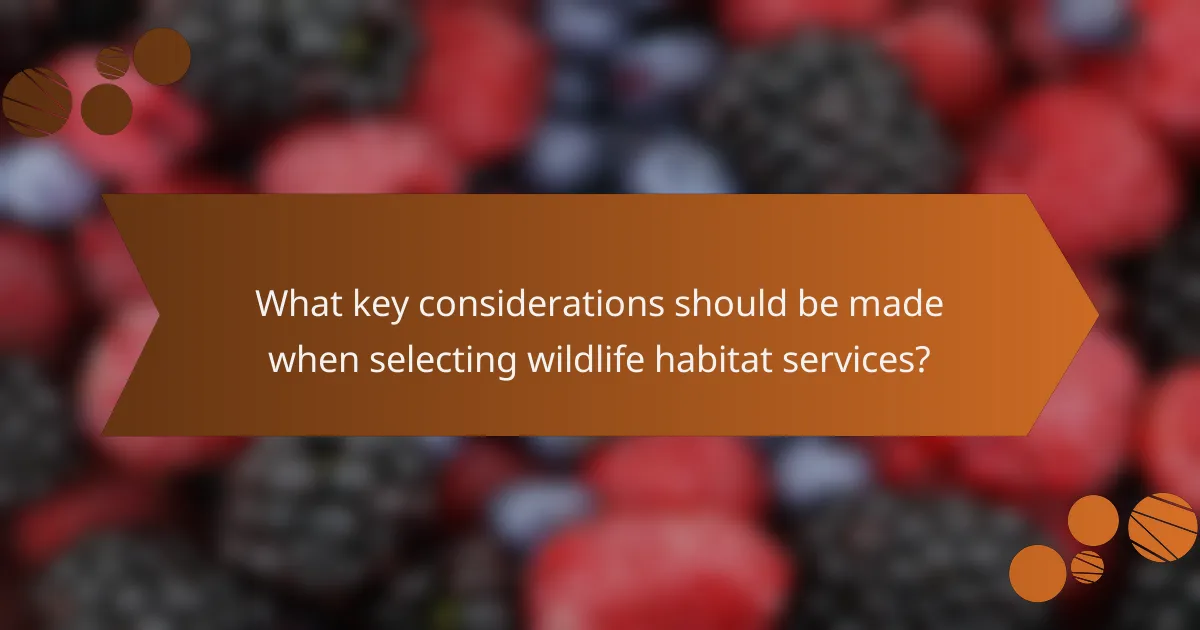
What key considerations should be made when selecting wildlife habitat services?
When selecting wildlife habitat services, it is crucial to consider site-specific assessments, regulatory compliance requirements, and community involvement. These factors ensure that the chosen services are effective, legally compliant, and supported by local stakeholders.
Site-specific assessments
Site-specific assessments evaluate the unique characteristics of a location, including its flora, fauna, and ecological conditions. Conducting these assessments helps identify the specific needs of wildlife and the potential impacts of habitat services. For example, a wetland area may require different management strategies compared to a forested region.
Utilizing tools such as Geographic Information Systems (GIS) can enhance the accuracy of these assessments. Engaging local ecologists or environmental consultants can provide valuable insights into the habitat’s current state and necessary interventions.
Regulatory compliance requirements
Understanding regulatory compliance is essential when implementing wildlife habitat services. Various local, state, and federal regulations may govern habitat restoration and management practices. Familiarity with laws such as the Endangered Species Act or local zoning ordinances can prevent legal issues and ensure project success.
It is advisable to consult with legal experts or regulatory agencies early in the planning process. This proactive approach can help identify necessary permits and avoid costly delays or penalties later on.
Community involvement and support
Community involvement is vital for the success of wildlife habitat services. Engaging local stakeholders fosters support and encourages collaboration, which can lead to more sustainable outcomes. Organizing community meetings or workshops can help gather input and build a sense of ownership among residents.
Additionally, educating the community about the benefits of wildlife habitats can enhance public support. Highlighting the ecological, recreational, and economic advantages can motivate community members to participate actively in habitat conservation efforts.
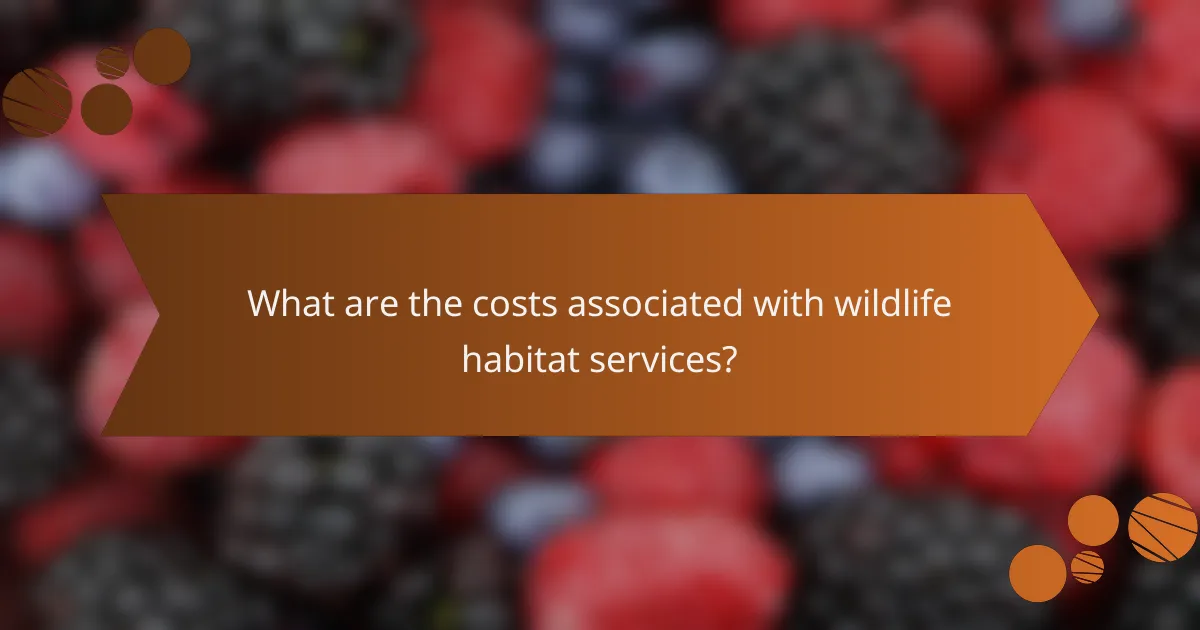
What are the costs associated with wildlife habitat services?
The costs associated with wildlife habitat services can vary widely based on the scope of the project, location, and specific restoration goals. Key expenses often include planning, implementation, ongoing maintenance, and monitoring to ensure the habitat remains viable.
Pricing models for habitat restoration
Pricing models for habitat restoration typically fall into several categories, including fixed-price contracts, cost-plus contracts, and performance-based pricing. Fixed-price contracts offer a set fee for the entire project, while cost-plus contracts charge for actual expenses plus a fee. Performance-based pricing ties costs to specific outcomes, incentivizing successful habitat restoration.
When selecting a pricing model, consider the complexity of the project and the level of risk involved. For example, fixed-price contracts may be beneficial for straightforward projects, while more complex restorations might require flexible cost-plus arrangements.
Funding options and grants
Various funding options and grants are available to support wildlife habitat services, including government programs, non-profit organizations, and private sector investments. In the U.S., programs like the Conservation Reserve Program (CRP) and Environmental Quality Incentives Program (EQIP) provide financial assistance for habitat restoration.
To access funding, applicants typically need to demonstrate the ecological benefits of their projects and comply with specific guidelines. Researching local, state, and federal grant opportunities can uncover valuable resources to offset costs.
Cost-benefit analysis of services
A cost-benefit analysis of wildlife habitat services helps stakeholders evaluate the economic feasibility of restoration projects. This analysis compares the costs of habitat restoration against the anticipated ecological and economic benefits, such as increased biodiversity, improved water quality, and enhanced recreational opportunities.
When conducting a cost-benefit analysis, consider both direct and indirect benefits. For instance, while the initial investment may be significant, the long-term advantages—such as increased tourism or reduced flood risks—can justify the expenditure. Engaging with local experts can provide insights into potential benefits specific to your area.
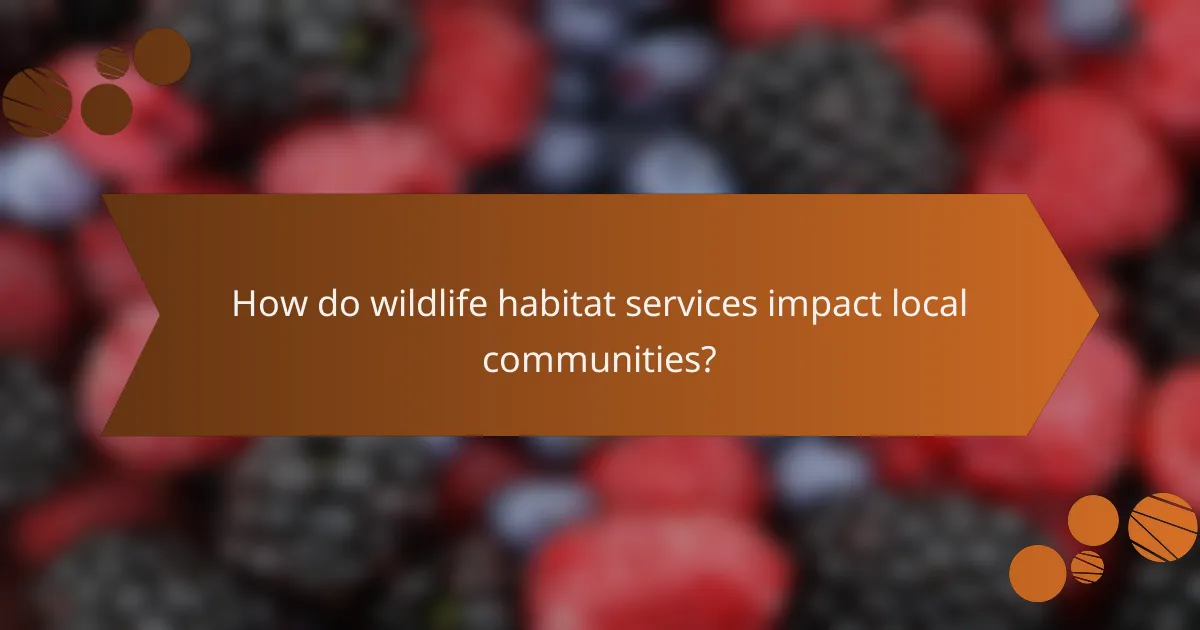
How do wildlife habitat services impact local communities?
Wildlife habitat services significantly benefit local communities by enhancing economic opportunities, improving public health, and providing educational resources. These services foster a connection between residents and their natural environment, leading to sustainable development and community well-being.
Economic benefits through ecotourism
Ecotourism thrives in areas with rich wildlife habitats, generating income for local communities. By attracting visitors interested in nature, communities can create jobs in hospitality, guiding, and conservation efforts. This economic boost can lead to improved infrastructure and services.
For example, a community near a national park can see increased revenue from entrance fees, guided tours, and local crafts sold to tourists. This influx of cash can support local businesses and promote sustainable practices that protect the environment.
Community health improvements
Access to natural habitats can lead to better physical and mental health for community members. Outdoor activities such as hiking, birdwatching, and nature walks encourage physical exercise and reduce stress levels. These activities can foster a sense of community and belonging.
Moreover, wildlife habitats often provide clean air and water, which are essential for public health. Communities that prioritize wildlife conservation may experience lower rates of respiratory issues and other health problems associated with pollution.
Educational opportunities for residents
Wildlife habitats serve as living classrooms, offering educational experiences for residents of all ages. Schools can organize field trips to local parks or reserves, where students learn about biodiversity, ecosystems, and conservation efforts. This hands-on learning can inspire future generations to value and protect their environment.
Additionally, local organizations may provide workshops and training sessions focused on wildlife conservation, sustainable practices, and environmental stewardship. These educational initiatives can empower residents to engage actively in preserving their natural surroundings.
